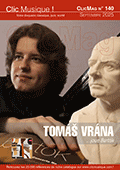 Yuan Sheng n’en est pas à son début chez Bach et j’ai un peu honte de l’y découvrir seulement maintenant. Je le sais aussi à l’aise au clavecin que sur des pianos anciens, est-ce-pour cela que le grand Steinway moderne qu’il joue ici se trouve si empli de couleurs ? Pour l’un des recueils les plus français de Bach, ce clavier versicolore est un atout majeur, mais Yuan Sheng ne s’en contente pas, il phrase, il danse, il fait aussi rêver son piano avec des trésors de nostalgie : écoutez seulement la Sarabande de la 5e Suite, si dite, si ployée, où le legato n’empêche pas les nuances de la phrase et rend les voix si élégantes. Tout le recueil s’écoute d’un trait, pianisme admirable de subtilités et de simplicité, discours expressif et pudique à la fois, et quelle belle surprise de trouver en appendices deux Suites supplémentaires, les BWV 818 et 819 que Bach écrivit à Cothen aux alentours de 1720. On les entend trop rarement, elles furent un temps au répertoire des pianistes, William Kappel jouait la première, écouter la version nostalgique de Yuan Sheng après celle du prodige américain éclaire l’œuvre d’une lumière rasante. Ce crépuscule est d’une beauté assez inouïe… (Discophilia - Artalinna.com) (Jean-Charles Hoffelé)  A Chinese-American Bach specialist continues a critically acclaimed cycle of the keyboard works. ‘This is superior Chopin playing by any standards,’ remarked Fanfare of Yuan Sheng’s 3CD Chopin collection (PCL0049) for Piano Classics in 2013. That was recorded on an 1845 Pleyel, whereas for his Bach series he has returned to the reliable pleasures of a modern Steinway. However, the qualities identified by Fanfare’s reviewer in his Chopin – ‘his sensitivity, his agility, his rhythmic strength’ are no less evident, as one might expect from a pupil of the sovereign Bach exponent on the modern piano, Rosalyn Tureck. The French Suites are often considered poorer or at least slighter cousins to the English Suites and Partitas. And it’s true that they were probably intended first and foremost for teaching purposes rather than public performance. Compiled during Bach’s time as Capellmeister to the court at Cothen in the early 1720s, they satisfied a need for good, exemplary pieces to stretch his pupils as his reputation as a teacher spread farther into Germany and beyond. The title is misleading: the English Suites are more ‘French’ in character than the French Suites, which are more characteristic of the Italian style. ‘By design the composer is here less learned than in his other suites,’ remarked one early biographer, ‘and has mostly used a pleasing, more predominant melody.’ Just so, and the same is true of the pair of suites BWV 818 and 819 which fall outside the collection but belong with it in terms of style. To all of them Yuan Sheng brings considered tempi and precise articulation in the mould of Tureck. To Bach at his most uncomplicated, Sheng brings the virtues of simplicity and clarity.
 |
